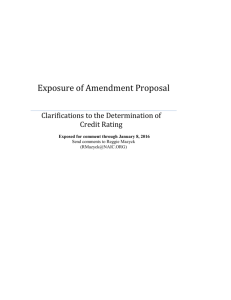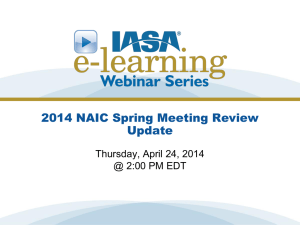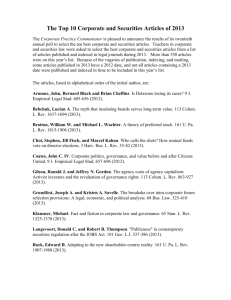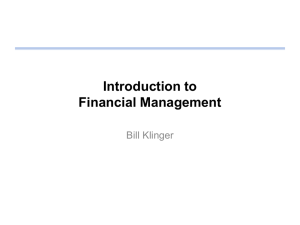Issue: Quarterly Reporting of RMBS and CMBS Purchased
advertisement
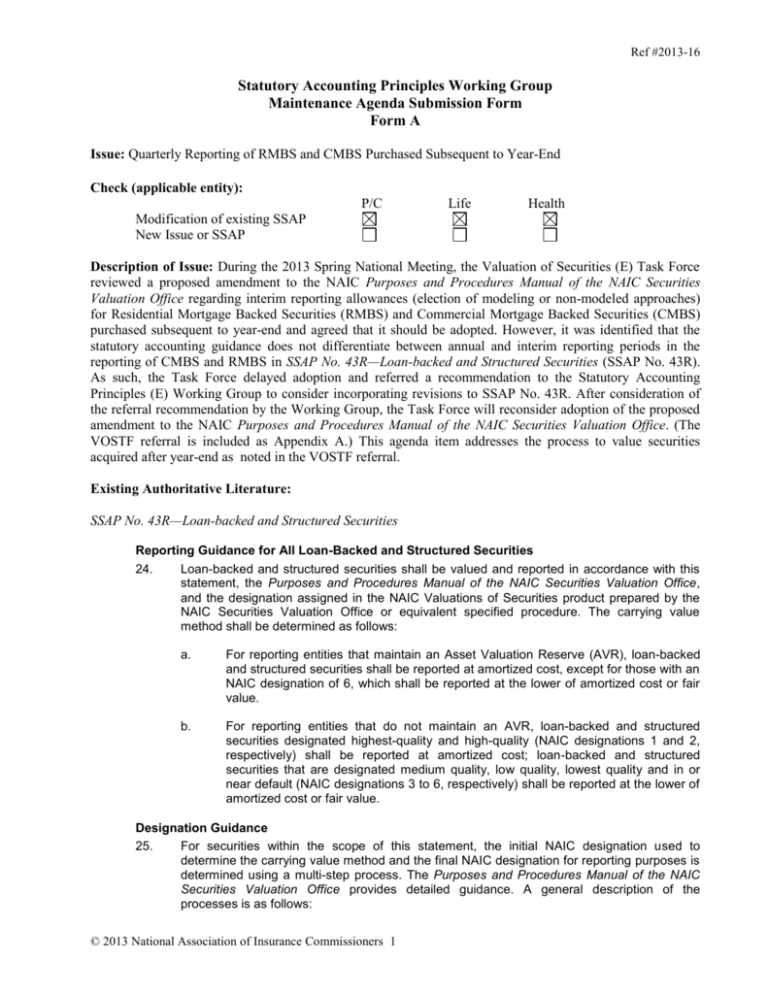
Ref #2013-16 Statutory Accounting Principles Working Group Maintenance Agenda Submission Form Form A Issue: Quarterly Reporting of RMBS and CMBS Purchased Subsequent to Year-End Check (applicable entity): P/C Life Health Modification of existing SSAP New Issue or SSAP Description of Issue: During the 2013 Spring National Meeting, the Valuation of Securities (E) Task Force reviewed a proposed amendment to the NAIC Purposes and Procedures Manual of the NAIC Securities Valuation Office regarding interim reporting allowances (election of modeling or non-modeled approaches) for Residential Mortgage Backed Securities (RMBS) and Commercial Mortgage Backed Securities (CMBS) purchased subsequent to year-end and agreed that it should be adopted. However, it was identified that the statutory accounting guidance does not differentiate between annual and interim reporting periods in the reporting of CMBS and RMBS in SSAP No. 43R—Loan-backed and Structured Securities (SSAP No. 43R). As such, the Task Force delayed adoption and referred a recommendation to the Statutory Accounting Principles (E) Working Group to consider incorporating revisions to SSAP No. 43R. After consideration of the referral recommendation by the Working Group, the Task Force will reconsider adoption of the proposed amendment to the NAIC Purposes and Procedures Manual of the NAIC Securities Valuation Office. (The VOSTF referral is included as Appendix A.) This agenda item addresses the process to value securities acquired after year-end as noted in the VOSTF referral. Existing Authoritative Literature: SSAP No. 43R—Loan-backed and Structured Securities Reporting Guidance for All Loan-Backed and Structured Securities 24. Loan-backed and structured securities shall be valued and reported in accordance with this statement, the Purposes and Procedures Manual of the NAIC Securities Valuation Office, and the designation assigned in the NAIC Valuations of Securities product prepared by the NAIC Securities Valuation Office or equivalent specified procedure. The carrying value method shall be determined as follows: a. For reporting entities that maintain an Asset Valuation Reserve (AVR), loan-backed and structured securities shall be reported at amortized cost, except for those with an NAIC designation of 6, which shall be reported at the lower of amortized cost or fair value. b. For reporting entities that do not maintain an AVR, loan-backed and structured securities designated highest-quality and high-quality (NAIC designations 1 and 2, respectively) shall be reported at amortized cost; loan-backed and structured securities that are designated medium quality, low quality, lowest quality and in or near default (NAIC designations 3 to 6, respectively) shall be reported at the lower of amortized cost or fair value. Designation Guidance 25. For securities within the scope of this statement, the initial NAIC designation used to determine the carrying value method and the final NAIC designation for reporting purposes is determined using a multi-step process. The Purposes and Procedures Manual of the NAIC Securities Valuation Office provides detailed guidance. A general description of the processes is as follows: © 2013 National Association of Insurance Commissioners 1 Ref #2013-16 a. b. Financial Modeling: The NAIC identifies securities where financial modeling must be used to determine the NAIC designation. NAIC designation based on financial modeling incorporates the insurers’ carrying value for the security. For those securities that are financially modeled, the insurer must use NAIC CUSIP specific modeled breakpoints provided by the modelers in determining initial and final designation for these identified securities. Securities where modeling results in zero expected loss in all scenarios are automatically considered to have a final NAIC designation of NAIC 1, regardless of the carrying value. The three-step process for modeled securities is as follows: i. Step 1: Determine Initial Designation – The current amortized cost (divided by remaining par amount) of a loan-backed or structured security is compared to the modeled breakpoint values assigned to the six (6) NAIC designations for each CUSIP to establish the initial NAIC designation. ii. Step 2: Determine Carrying Value Method – The carrying value method, either the amortized cost method or the lower of amortized cost or fair value method, is then determined as described in paragraph 24 based upon the initial NAIC designation from Step 1. iii. Step 3: Determine Final Designation – The final NAIC designation that shall be used for investment schedule reporting is determined by comparing the carrying value (divided by remaining par amount) of a security (based on paragraph 25a.ii.) to the NAIC CUSIP specific modeled breakpoint values assigned to the six (6) NAIC designations for each CUSIP. This final NAIC designation shall be applicable for statutory accounting and reporting purposes (including establishing the AVR charges). The final designation is not used for establishing the appropriate carrying value method in Step 2 (paragraph 25.a.ii.). Modified Filing Exempt Securities: The modified filing exempt method is for securities that are not subject to modeling under paragraph 25.a., and is further defined in the Purposes and Procedures Manual of the NAIC Securities Valuation Office and have a NAIC Acceptable Rating Organization (ARO) rating. The four-step process for these securities is similar to the three-step process described in paragraph 25.a.i. through 25.a.iii. i. Step 1: Translate ARO Rating – Translate ARO Rating to the NAIC Designation Equivalent in accordance with the Purposes and Procedures Manual of the NAIC Securities Valuation Office. If the result is NAIC 1 or NAIC 6, the remaining steps do not need to be performed; use the NAIC 1 or NAIC 6 to establish the appropriate carrying value methodology per paragraph 24 and report the NAIC 1 or NAIC 6 as the Final Designation. For NAIC 2 through NAIC 5, proceed to Step 2. ii. Step 2: Determine Initial Designation – Use the NAIC 2 through NAIC 5 from Step 1 to identify the appropriate breakpoints from the pricing matrix (see table, “NAIC Designations Breakpoints for Loan-Backed and Structured Securities” provided in Part Three Section 3 (c) (iv) (A) of the Purposes and Procedures Manual of the NAIC Securities Valuation Office) and compare to the amortized cost (divided by outstanding par) to determine the initial NAIC designation. iii. Step 3: Determine Carrying Value Method – The carrying value method, either the amortized cost method or the lower of amortized cost or fair value method, is then determined as described in paragraph 24 based upon the initial NAIC designation determined in Step 2. © 2013 National Association of Insurance Commissioners 2 Ref #2013-16 iv. c. Step 4: Determine Final Designation – If the appropriate carrying value methodology established in Step 3 results in the security being carried at amortized cost (including securities where the carrying value method is lower of amortized cost or fair value where the amortized cost is the lower value), then the final NAIC designation is the same as the initial NAIC designation. If the appropriate carrying value methodology established in Step 3 results in the security being carried at fair value (thus the carrying value method is lower of amortized cost and fair value, and the fair value is the lower value), use the converted ARO rating NAIC designation from Step 2 to identify the appropriate breakpoints from the pricing matrix and compare to the fair value (divided by outstanding par) to determine the final NAIC designation. This final NAIC designation shall be applicable for statutory accounting and reporting purposes (including establishing the AVR charges). The final NAIC designation is not used for establishing the appropriate carrying value method in Step 3 (paragraph 25.b.ii.). All Other Loan-Backed and Structured Securities: For loan-backed and structured securities not subject to paragraphs 25.a. (financial modeling) or 25.b. (modified filing exempt), follow the established designation procedures according to the appropriate section of the Purposes and Procedures Manual of the NAIC Securities Valuation Office. The NAIC designation shall be applicable for statutory accounting and reporting purposes (including determining the carrying value method and establishing the AVR charges). The carrying value method is established as described in paragraph 24. Examples of these securities include, but are not limited to, equipment trust certificates, credit tenant loans (CTL), 5*/6* securities, interest only (IO) securities, and loan-backed and structured securities with SVO assigned NAIC designations. Activity to Date (issues previously addressed by SAPWG, Emerging Accounting Issues WG, SEC, FASB, other State Departments of Insurance or other NAIC groups): These items pertain to SSAP No. 43R, but are not related to the VOSTF designation guidance: Agenda Item 2011-10: Schedule for SSAP No. 43R Disclosures - This agenda item proposed revisions to move the individual security disclosures reflected in paragraph 48g of SSAP No. 43R from the financial statement notes and include them within an annual and quarterly schedule. During the 2011 Summer National Meeting, the Working Group formed a subgroup to develop and recommend a disclosure schedule. Consideration of this item has been postponed due to more pressing projects. Additionally, interested parties have requested a review of securities within scope of SSAP No. 43R – particularly for securities with single-payers (e.g., credit tenant loans). Agenda Item 2013-15: Consolidate SSAP No. 43R Footnote Disclosures – This agenda item was referred by David Chellgren from Conning Inc. and recommends revisions to SSAP No. 43R to only require impairment disclosures for securities with an OTTI recognized in the current year. This item is scheduled for original discussion during the 2013 Summer National Meeting. Information or issues (included in Description of Issue) not previously contemplated by the SAPWG: A previous agenda item 2012-12 addressed changing Acceptable Rating Organizations (ARO) to Credit Rating provider (CRP), but it seems to have overlooked updating SSAP No. 43R, paragraph 25. Staff Recommendation: Summary Recommendation - It is recommended that the Working Group move this item to the nonsubstantive active listing and expose nonsubstantive revisions to SSAP No. 43R to incorporate accounting and reporting guidance for interim financial statements. The VOSTF proposed language incorporates an interim reporting option for RMBS and CMBS securities acquired subsequent to year-end. Under the proposed Task Force language, for quarterly financial statement reporting, the insurer © 2013 National Association of Insurance Commissioners 3 Ref #2013-16 could elect to either 1) use the prior year-end modeling data for the particular RMBS/ CMBS CUSIP and apply the financial modeling methodology, or 2) follow the analytical procedures applicable to RMBS/ CMBS securities that are not subject to the financial modeling methodology. This optionality has been proposed as: 1) Not all reporting entities acquire the financial modeling data for all RMBS/ CMBS securities, and such entities only purchase the financial modeling data for the specific securities owned as of year-end. For acquisitions in the subsequent year, without the ability to follow the analytical procedures specified in the Practices and Procedures Manual of the NAIC Securities Valuation Office, these entities would be required to purchase the prior year-end modeling data, which would not be updated until current year-end. 2) Not all RMBS and CMBS securities acquired in the subsequent year may have been included in the financial modeling data for the prior year. For these securities to be modeled, they would need to be reported through the NAIC RMBS/ CMBS process. As the financial modeling process currently only occurs at year-end, these securities would not be financially modeled for interim reporting. 3) For those entities that acquire the financial modeling data for all securities, there is the desire to maintain a consistent valuation approach from the year-end reporting. As such, these entities want to continue using the prior-year end modeling data for their quarterly reporting. In reviewing the proposal from the Task Force, it is first noted that statutory accounting principles generally attempt to avoid optionality within the financial statements. By avoiding optionality, the financial statements can be consistently evaluated and compared to other reporting entities. However, there are limited instances within the statutory financial statements that do allow optionality between different accounting methods. In considering this specific proposal for statutory accounting, the following key items are noted: 1. Proposal is only for interim financial reporting periods: Regardless of the valuation process used for the interim financial reporting securities, RMBS/CMBS securities would be valued in accordance with the designation guidance in SSAP No. 43R for year-end reporting. 2. The quarterly filings only detail disposals and acquisitions within the quarter: Although the aggregate value of all securities is reflected within the interim balance sheet security level detail is not provided. 3. Accounting for variations between interim and year-end methodologies: If the optionality is supported for interim reporting on acquisitions subsequent to year-end, any changes from amortized cost to fair value would follow existing guidance (unrealized gain or loss recognition). 4. Limitations to optionality: If the different reporting methods are supported for interim reporting, consideration should occur regarding whether to prescribe the specific method each entity needs to follow in reporting the securities. This approach would still result with some inconsistency between entities in interim reporting, but it would eliminate the entity’s elections on which valuation methodology to apply. For example: a. Entities that acquired the entire financial modeling database for the prior-year end could be required to follow the financial modeling methodology for all securities acquired in subsequent year acquisitions that were included in the financial modeling data previously acquired. © 2013 National Association of Insurance Commissioners 4 Ref #2013-16 b. Entities that acquire identical securities (identical CUSIP) to those held (and financially modeled) at the prior year-end could be required to follow the prior-year financial modeling methodology for subsequent year acquisitions. c. Entities that did not acquire the entire prior-year financial modeling database, and acquired a security that was not identical to a security already owned at the prior year-end would be required to follow the analytical procedures for non-financially modeled securities. (Although the security may have been modeled at the prior-year end and included in the financial model database, this approach would not require the entity to purchase the prior-year end modeling data for subsequent year interim financial statements) d. Entities that acquire securities not previously modeled at year-end would be required to follow the analytical procedures for non-financially modeled securities. 5. A previous agenda item (ref #2012-12) addressed replacing “Acceptable Rating Organizations” (ARO) to “Credit Rating provider” (CRP), but it seems to have overlooked updating SSAP No. 43R, paragraph 25. As such, these reference revisions are recommended. Proposed Recommendations to SSAP No. 43R: Designation Guidance 25. For securities within the scope of this statement, the initial NAIC designation used to determine the carrying value method and the final NAIC designation for reporting purposes is determined using a multi-step process. The Purposes and Procedures Manual of the NAIC Securities Valuation Office provides detailed guidance. A general description of the processes is as follows: a. Financial Modeling: The NAIC identifies securities where financial modeling must be used to determine the NAIC designation. NAIC designation based on financial modeling incorporates the insurers’ carrying value for the security. For those securities that are financially modeled, the insurer must use NAIC CUSIP specific modeled breakpoints provided by the modelers in determining initial and final designation for these identified securities. Securities where modeling results in zero expected loss in all scenarios are automatically considered to have a final NAIC designation of NAIC 1, regardless of the carrying value. The three-step process for modeled securities is as follows: i. Step 1: Determine Initial Designation – The current amortized cost (divided by remaining par amount) of a loan-backed or structured security is compared to the modeled breakpoint values assigned to the six (6) NAIC designations for each CUSIP to establish the initial NAIC designation. ii. Step 2: Determine Carrying Value Method – The carrying value method, either the amortized cost method or the lower of amortized cost or fair value method, is then determined as described in paragraph 24 based upon the initial NAIC designation from Step 1. iii. Step 3: Determine Final Designation – The final NAIC designation that shall be used for investment schedule reporting is determined by comparing the carrying value (divided by remaining par amount) of a security (based on paragraph 25a.ii.) to the NAIC CUSIP specific modeled breakpoint values assigned to the six (6) NAIC designations for each CUSIP. This final NAIC designation shall be applicable for statutory accounting and reporting purposes (including establishing the AVR charges). The final designation is not used for establishing the appropriate carrying value method in Step 2 (paragraph 25.a.ii.). © 2013 National Association of Insurance Commissioners 5 Ref #2013-16 b. c. Modified Filing Exempt Securities: The modified filing exempt method is for securities that are not subject to modeling under paragraph 25.a., and is further defined in the Purposes and Procedures Manual of the NAIC Securities Valuation Office and have a NAIC Credit Rating Provider (CRP) rating. The four-step process for these securities is similar to the three-step process described in paragraph 25.a.i. through 25.a.iii. i. Step 1: Translate ARO Rating – Translate CRP Rating to the NAIC Designation Equivalent in accordance with the Purposes and Procedures Manual of the NAIC Securities Valuation Office. If the result is NAIC 1 or NAIC 6, the remaining steps do not need to be performed; use the NAIC 1 or NAIC 6 to establish the appropriate carrying value methodology per paragraph 24 and report the NAIC 1 or NAIC 6 as the Final Designation. For NAIC 2 through NAIC 5, proceed to Step 2. ii. Step 2: Determine Initial Designation – Use the NAIC 2 through NAIC 5 from Step 1 to identify the appropriate breakpoints from the pricing matrix (see table, “NAIC Designations Breakpoints for Loan-Backed and Structured Securities” provided in Part Three Section 3 (c) (iv) (A) of the Purposes and Procedures Manual of the NAIC Securities Valuation Office) and compare to the amortized cost (divided by outstanding par) to determine the initial NAIC designation. iii. Step 3: Determine Carrying Value Method – The carrying value method, either the amortized cost method or the lower of amortized cost or fair value method, is then determined as described in paragraph 24 based upon the initial NAIC designation determined in Step 2. iv. Step 4: Determine Final Designation – If the appropriate carrying value methodology established in Step 3 results in the security being carried at amortized cost (including securities where the carrying value method is lower of amortized cost or fair value where the amortized cost is the lower value), then the final NAIC designation is the same as the initial NAIC designation. If the appropriate carrying value methodology established in Step 3 results in the security being carried at fair value (thus the carrying value method is lower of amortized cost and fair value, and the fair value is the lower value), use the converted ARO rating NAIC designation from Step 2 to identify the appropriate breakpoints from the pricing matrix and compare to the fair value (divided by outstanding par) to determine the final NAIC designation. This final NAIC designation shall be applicable for statutory accounting and reporting purposes (including establishing the AVR charges). The final NAIC designation is not used for establishing the appropriate carrying value method in Step 3 (paragraph 25.b.ii.). All Other Loan-Backed and Structured Securities: For loan-backed and structured securities not subject to paragraphs 25.a. (financial modeling) or 25.b. (modified filing exempt), follow the established designation procedures according to the appropriate section of the Purposes and Procedures Manual of the NAIC Securities Valuation Office. The NAIC designation shall be applicable for statutory accounting and reporting purposes (including determining the carrying value method and establishing the AVR charges). The carrying value method is established as described in paragraph 24. Examples of these securities include, but are not limited to, equipment trust certificates, credit tenant loans (CTL), 5*/6* securities, interest only (IO) securities, and loan-backed and structured securities with SVO assigned NAIC designations. © 2013 National Association of Insurance Commissioners 6 Ref #2013-16 Specific Interim Reporting Guidance for RMBS/CMBS Securities 26. The guidance in this paragraph shall be applied in determining the reporting method for RMBS/ CMBS securities acquired in the current year for quarterly financial statements. Securities reported as of the prior-year end shall continue to be reported under the prior-year end methodology for the current-year quarterly financial statements. For year-end reporting, securities shall be reported in accordance with paragraph 25, regardless of the quarterly methodology used. a. Reporting entities that acquired the entire financial modeling database for the prior-year end are required to follow the financial modeling methodology (paragraph 25.a.) for all securities acquired in the subsequent year that were included in the financial modeling data acquired for the prior year-end. b. Reporting entities that acquired identical securities (identical CUSIP) to those held and financially modeled for the prior year-end are required to follow the prior year-end financial modeling methodology (paragraph 25a) for these securities acquired subsequent to year-end. c. Reporting entities that do not acquire the prior-year financial modeling information for currentyear acquired individual CUSIPS, and are not captured within paragraphs 26a or 26b, are required to follow the analytical procedures for non-financially modeled securities (paragraph 25.b. or paragraph 25.c. as appropriate). Reporting entities that do acquire the individual CUSIP information from the prior-year financial modeling database shall use that information for interim reporting. d. Reporting entities that acquire securities not previously modeled at the prior year-end are required to follow the analytical procedures for non-financially modeled securities (paragraph 25.b. or paragraph 25.c. as appropriate). (Remaining paragraphs to be renumbered accordingly.) Staff Review Completed by: Julie Gann – June 2013 G:\DATA\Stat Acctg\1. Statutory\A. Maintenance\a. Form A\1. Active Form A's\13-16 - 43R VOSTF Quarterly Reporting.doc © 2013 National Association of Insurance Commissioners 7

